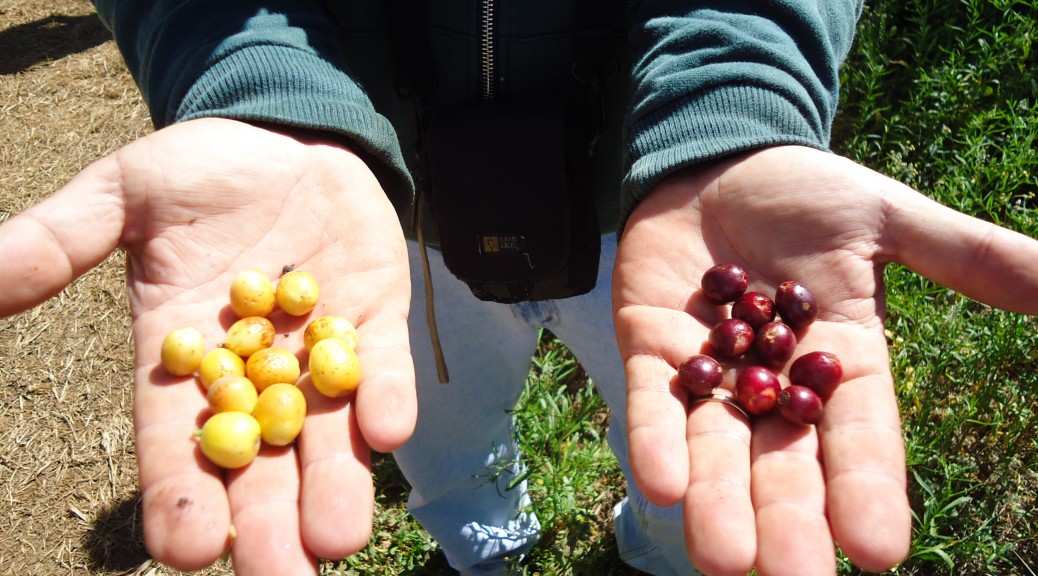Look at any decent wine list in a restaurant or the display of bottles in a shop, and you’ll see the wines arranged by country (or region) of origin, and then by the kind of grape. Then take a look at the selection of coffees available at a specialty coffee shop. For years we’ve been buying coffee based on the country it comes from; buying it based on the kind of bean is a newer development. But these days it’s more and more likely that you’ll see a coffee listed not as, say, a Guatemalan Coban, but just Coban.
There’s more out there than just Arabica and Robusta.
Most people have heard of Arabica and Robusta, the two most common types of coffee. Conventional wisdom says that Arabica beans, which tend to be sweeter, softer, and have higher acidity, are better than the more hardy, higher-yielding Robusta. But there’s a whole lot more to the story. Just like there are hundreds of different wine grapes out there, under the umbrellas of Arabica and Robusta there are hundreds of different coffee cultivars, too. (By the way, we use the word “cultivar” to indicate a variety that has been cultivated by people, rather than a “varietal” that developed on its own in nature.)
Our Sweet Yellow Brazilian coffee is a blend of three Arabica cultivars: Yellow Bourbon, Catuai, and Caturra. The “sweet” and “yellow” part of the name comes from the qualities of the cultivars. Yellow Bourbon is known for being particularly sweet, while Catuai and Caturra contribute more acidity for balance. All three cultivars have bright yellow cherries when they’re ripe. The bean we roast is the seed of the cherry; the flesh of the cherry is removed during processing.
A lot of coffee cultivars are pretty new.
In the grape world, Cabernet Sauvignon qualifies as a “relatively recent” development since it’s only been grown since the 17th century. While grapes have been grown for wine for millennia, coffee has only been cultivated since the 15th century. Many of the coffee cultivars that are making a name for themselves today have only been in production for a few decades.
All three of the cultivars in Sweet Yellow are fairly young, and all Brazilian in origin. Their story starts in 1871, when the first Bourbon beans were brought to Brazil from the Island of Bourbon off the coast of Madagascar. The first Caturra beans showed up about 35 years later; they were was a natural mutation of Bourbon beans. The first Yellow Bourbon beans were discovered in 1930, a hybrid of Bourbon and a local cultivar with yellow cherries. Catuai was developed in 1949 as a cross between Caturra and another local cultivar.
Once you’ve got the beans, you need to treat them carefully to get great coffee.
Each year, due to changes in weather or other variable factors, each of the three cultivars in Sweet Yellow may be a bit different. The growers at DaTerra estate watch these changes carefully and make adjustments to the blend to produce a consistent cup of coffee. Some years they may adjust the ratio of each cultivar, or they may adjust how each cultivar is processed to achieve the desired flavor: nutty, chocolatey, with good acidity and a clean finish. By the time each batch of Sweet Yellow is shipped up to our Coffee Company to be roasted, it’s been tasted (and potentially fine tuned) a dozen times on the estate to ensure it’s exactly what we want.
What we do with the coffee at home has a big impact, too.
The baristas at Zingerman’s Coffee Company particularly recommend brewing the Sweet Yellow in a chemex, with a syphon, or as an espresso. Each different brewing method with emphasize slightly different qualities in the coffee and give us slightly different flavors. But don’t worry if your kitchen isn’t decked out with all the latest in coffee gadgetry; I’ve brewed a great pot of drip coffee using the Sweet Yellow, too. And don’t worry about having to drink it all right away—Sweet Yellow stays bright, smooth, and delicious even after it’s cooled down to room temperature.
Just like certain wines pair better with certain foods, certain coffees are better alongside certain foods, too. The cocoa notes of Sweet Yellow make it a natural pair for chocolate; I love it alongside our hot cocoa coffeecake or a chocolate dipped fig for an indulgent mid-morning snack. It’s bright acidity also goes well with citrus, like mandarin oranges. And its moderate, well-balanced body make it an ideal cup for starting off your morning—especially alongside some waffles or pancakes.

